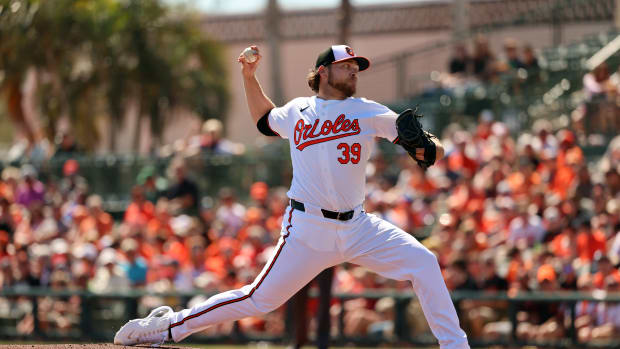No Pujols, no problem for Cardinals
With players like Allen Craig stepping into larger roles, the Cardinals haven't missed a beat in 2012. (AP)
Even before Albert Pujols officially left via free agency, few people suggested that the Cardinals would find their way back to the World Series so quickly. "Cardinals fans are praying," suggested ESPN's Gene Wojciechowski after the team's Game 7 win, "Praying that the 31-year-old Pujols… returns to St. Louis for a 12th year — and much, much longer. With him, the Cardinals have won two world championships and played for a third. Without him — well, nobody here wants to imagine what that would be like." They're not back to the World Series yet, but the Cardinals stand just one win away from a return, which they can clinch with a win in Game 6 of the National League Championship Series tonight in San Francisco.
Life after Pujols, while no cakewalk, isn't the unimaginable struggle that some expected it to be. Without Pujols, who signed with the Angels last December for 10 years and $240 million, the Cardinals went 88-74 this year, two wins fewer than last season. Their offense didn't exactly suffer his loss, scoring three runs more than in 2011, while their pitching and defense actually prevented 44 fewer runs; the team underachieved its Pythagorean record by five games, after overachieving by two games last year, a fluctuation that may owe something to a shakier bullpen. Either way, they had to take the wild-card route into the postseason, this time by winning a play-in game over the Braves — whom, you may recall, they edged out for a playoff spot on the final day of the 2011 season after being more or less left for dead down the stretch. Not exactly a striking difference there.
St. Louis didn't have as much trouble replacing Pujols as one might have expected for three key reasons: depth, payroll freedom and the slugger's own decline. Consider the latter factor first. Despite the world championship, Pujols' performance had taken a noticeable hit in 2011, his age 31 season. After hitting a combined .331/.426/.624 while averaging 41 homers and 91 walks from 2001-2010 — simply one of the most dominant decades in baseball history — Pujols fell off to .299/.366/.541 with 37 homers and 61 walks in 2011. Never before had he failed to reach a .300 average, and while the fall-off in that department was trivial, his on-base percentage was 28 points lower than his previous career worst, and 48 points lower than in 2010; likewise, his slugging percentage was 20 points lower than his career worst, and 55 points off his 2010 mark. He grew less disciplined as a hitter, swinging far more often at pitches outside the strike zone, and where he had averaged 8.5 Wins Above Replacement (Baseball-Reference version) from 2006-2010, he was worth "just" 5.1 WAR in 2011.
Obviously, it's a whole lot easier to replace a five-win player than an eight- or nine-win one. The challenge is doing so without blowing a hole in your budget, and to the credit of St. Louis general manager John Mozeliak, he did while remaining more or less payroll-neutral. The team's spending on salaries increased by just over $1 million from 2011 ($109.8 million) to 2012 ($111.0 million), a 1.1 percent increase in an industry that experienced 4.4 percent payroll inflation (all salary figures via Cot's Contracts at Baseball Prospectus).
Pujols made a well-below-market $16 million in 2011, but few Cardinals received substantial raises for 2012. Lance Berkman jumped from $8 million to $12 million, and Jaime Garcia from $437,000 to $3.4 million, while the $3.3 million the team paid to departing shortstop Ryan Theriot increased to $6.5 million paid to the incoming Rafael Furcal. Meanwhile, Adam Wainwright's boost from $6.7 million to $9 million was more than offset by Chris Carpenter's drop from $15 million to a backloaded two-year, $21 million deal that cost just $8.5 million for this season. All of which (along with other small raises) still left Mozeliak enough room to sign Carlos Beltran to a two-year, $26 million deal, split evenly between 2012 and 2013.
Not all of that payroll translated directly into productivity. Berkman's money was basically a sunk cost due to calf and knee injuries that limited him to 97 plate appearances and led him contemplate retirement. Carpenter's salary was almost as big a writeoff as Wainwright's had been the year before, with the former's thoracic outlet syndrome limiting him to three starts where the latter's 2011 season had been wiped out entirely by Tommy John surgery.
On the other hand, the team got a huge year from Beltran (.269/.346/.495 with 32 homers), who enjoyed his first season free of the disabled list since 2008. World Series heroes David Freese and Allen Craig, who combined for 582 plate appearances and 21 homers in 2011, saw those numbers essentially double to 1,081 plate appearances and 41 homers this year, with rookie Matt Carpenter filling Craig's role as a key extra bat with enough versatility play both the infield and outfield. Meanwhile, Yadier Molina stepped with a career year that could garner him the NL MVP award, hitting .315/.373/.501 with 22 homers in about nine percent more playing time than in 2011 — no small feat for a workhorse backstop — and Matt Holliday and John Jay, while essentially swapping places on the sidelines due to injury, combined to deliver a very similar performance across even more playing time than in 2011.
It may be easier to appreciate the way it all panned out via this table:
2011 | PA | HR | AVG | OBP | SLG | WAR |
| 2012 | PA | HR | AVG | OBP | SLG | WAR | Dif |
Pujols + Berkman | 1238 | 68 | .300 | .388 | .544 | 8.4 |
| Craig + Beltran | 1133 | 54 | .286 | .350 | .508 | 5.8 | -2.6 |
Pujols + Berkman + Craig + Freese | 1820 | 89 | .301 | .377 | .524 | 12.2 |
| Craig + Beltran + Freese + Carpenter | 2040 | 80 | .290 | .359 | .489 | 10.4 | -1.8 |
|
|
|
|
|
|
|
|
|
|
|
|
|
|
|
|
4 + Molina | 2338 | 103 | .302 | .371 | .510 | 14.8 |
| 4 + Molina | 2603 | 102 | .295 | .362 | .492 | 17.1 | +2.3 |
Jay + Holliday | 1019 | 32 | .296 | .366 | .474 | 6.3 |
| Jay + Holliday | 1190 | 31 | .299 | .377 | .456 | 7.1 | +0.8 |
Core 7 Total | 3357 | 135 | .300 | .370 | .499 | 21.1 |
| Core 7 Total | 3793 | 133 | .296 | .366 | .481 | 24.2 | +3.1 |
By themselves, Craig and Beltran didn't offset the contributions of Pujols and Berkman, though their production was fairly robust. But once you consider Molina's outstanding season and the additional availability of the core players as a group, it becomes apparent that the Cardinals were able to scale similar productivity across a larger footprint of playing time. Setting Berkman's 2012 contributions aside, the seven spots in question had 13 percent more plate appearances and 15 percent more value in 2012 than their counterparts in 2011.
It takes a fair bit of luck — particularly with regards to injuries — for such a positive result, but as Branch Rickey famously said, luck is the residue of design, and Mozeliak operating with a sound team-building strategy. The 2012 core was actually a whisker younger in terms of average age (weighted by plate appearance) than the 2011 one, and saw increased playing time for the under-30s entering or still in their primes (Carpenter, Craig, Jay, Molina and Freese) as the resurgent 35-year-olds (Berkman in 2011, Beltran in 2012) canceled each other out out, and the 31-year-old superstar whose career had begun its decline left town.




































